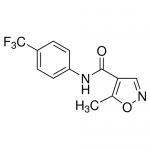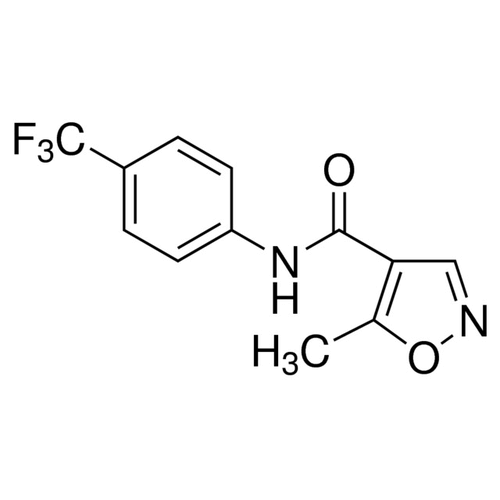| Product Name | Leflunomide |
| Description |
Immunosupressant |
| Purity | >98% (TLC: 5:95, CH3OH/CH2Cl2; Rf=0.65); NMR (Conforms) |
| CAS No. | 75706-12-6 |
| Molecular Formula | C12H9F3N2O2 |
| Molecular Weight | 270.21 |
| Field of Use | Not for use in humans. Not for use in diagnostics or therapeutics. For in vitro research use only. |
Properties
| Storage Temperature | -20ºC |
| Shipping Temperature | Shipped Ambient |
| Product Type | Inhibitor |
| Solubility | May be dissolved in DMSO (30 mg/ml); or Ethanol (27 mg/ml) |
| Source | Synthetic |
| Appearance | White crystalline solid |
| SMILES | CC1=C(C=NO1)C(=O)NC2=CC=C(C=C2)C(F)(F)F |
| InChI | InChI=1S/C12H9F3N2O2/c1-7-10(6-16-19-7)11(18)17-9-4-2-8(3-5-9)12(13,14)15/h2-6H,1H3,(H,17,18) |
| InChIKey | VHOGYURTWQBHIL-UHFFFAOYSA-N |
| Safety Phrases |
Classification: Caution: Substance not yet fully tested. Safety Phrases: S22 - Do not breathe dust S24/25 - Avoid contact with skin and eyes S36/37/39 - Wear suitable protective clothing, gloves and eye/face protection Risk Phrases: R25 – Toxic if swallowed R62 – Possible risk of impaired fertility R63 – Possible risk of harm to the unborn child Hazard Phrases: H301 – Toxic if swallowed. H315 – Causes skin irritation. H319 – Causes serious eye irritation H335 – May cause respiratory irritation Precautionary Phrases: P264 – Wash hands thoroughly after handling P280 – Wear protective gloves/protective clothing/eye protection/ face protection P301+310 - IF SWALLOWED: Immediately call a POISON CENTER or doctor/physician P308+313 - If exposed or concerned: Get medical advice/attention |
| Cite This Product | Leflunomide (StressMarq Biosciences Inc., Victoria BC CANADA, Catalog # SIH-368) |
Biological Description
| Alternative Names | 5-methyl-N-[4-(trifluoromethyl) phenyl]-isoxazole-4-carboxamide |
| Research Areas | Cell Signaling, Neuroscience |
| PubChem ID | 3899 |
| Scientific Background | Leflunomide is an immunomodulatory agent that inhibits dihydroorotate dehydrogenase, thereby suppressing pyrimidine synthesis and T-cell proliferation. In neuroscience, leflunomide is explored for its anti-inflammatory properties, particularly in models of neuroinflammation and autoimmune neurological disorders such as multiple sclerosis. By modulating immune responses, leflunomide helps elucidate the role of peripheral and central immune mechanisms in neurodegenerative disease progression. Its application in neuroimmunology research supports the development of therapeutic strategies targeting immune-mediated neuronal damage. |
| References |
1. Fukushima R., Kanamori S., Hirashiba M., et al. (2007) Reprod. Toxical. 24(3-4): 310-316. 2. Smolen JS., Emery P. (2000) Rheumatology. 39: 48-56. 3. Fox R.I., Herrman M.L., Franqou C.G., Wahl G.M., Morns R.E., Strand V. and Kirschbaum B.S. (1999) Clin Immunol 93(3): 198-208. |



Reviews
There are no reviews yet.